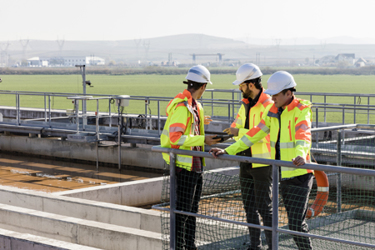Biotechnology Innovations Extend Life, Resilience Of Wastewater Infrastructure
By Dave Shackleton

In the daily rush to ensure that all the mechanical, electrical, and operational procedures are followed — monitoring inflow volumes and organic/nutrient loads; servicing and maintaining motors, pumps, and other electrical and mechanical equipment; maintaining chemical treatments to ensure effluent compliance — it is too easily forgotten that wastewater treatment is primarily a biological process.
Wastewater treatment infrastructure is designed to create an optimal environment for these biological processes. By constructing anaerobic digesters, biofilters, activated sludge tanks, and the like, we are trying to create an artificial aquatic environment in which microbes can best perform their function of taking up nutrients from the wastewater to produce a microbial sludge biomass. We then separate that nutrient-rich microbial sludge from the water in clarifiers to leave the treated effluent with a much-reduced level of those nutrients.
Current Infrastructure Design
When designing this infrastructure, we make performance assumptions on the metabolic processes that microbes use to proliferate and produce biomass. We then specify retention times, tank and clarifier dimensions, etc. based on other assumptions we make about average hydraulic and organic loads, etc.
These assumptions are based on averages, but in nature conditions are never average. That is an artificial construct used to justify our assumptions. So, there is always a discrepancy between the set of assumptions made by the designers of the plants and the reality of the dynamics experienced by operators of the plants.
Deviations Threaten Man-Made Systems
Deviations from the assumptions in man-made systems are not regular, predictable, or consistent. They may be seasonal and climate- or weather-related or reflected in the daily ablution patterns of urban populations, which tend to be concentrated into just a few hours each day.
However, these specific variations will generally vary within a fairly consistent range, and in general comply with the assumptions. But when there are major shocks to the system — a pump station fails, an aerator fails, there is a power outage for a prolonged period, or a major stormwater event flushes the plant — we inevitably resort to trying to manipulate the electrical, mechanical, and chemical aspects of our treatment infrastructure to combat the effects of these events, because this is all we can do.
Yet, because we are operating man-made aquatic ecosystems, they behave as complex adaptive systems and do not obey the Newtonian laws of physics that govern our electrical and mechanical interventions.
This is because these outlier events can cause shifts and changes in the ecosystem that cannot be reversed by simply manipulating the mechanical and electrical actions under our control. Such disruptions can cause ecosystem changes that do not easily reverse. The result is a changed biome in the wastewater treatment units that can compound with repeated events to permanently change the plant’s core biological performance.
Often, the only way to combat this is to build new infrastructure, and this often means that existing infrastructure is decommissioned and abandoned, despite the fact that it could still function effectively if the right biological interventions were made.
Biotechnology Platform Supports Resilience
Modern developments in technology are providing ways to directly address the biological performance of our man-made aquatic ecosystems to boost nutrient-removal capacity and sustain optimal performance even in the midst of shocks to the system.
Biotechnology that is supported by more sophisticated, energy-efficient aeration and oxygenation equipment increases plant capacity by directly addressing the metabolic processes that drive nutrient removal at the biochemical level. The result of this increased capability is more consistent biological nutrient removal, reduced costs, and life made easier for operators.
The benefits for executives responsible for capital allocation, financial control, and performance include:
- boosted biological performance translates into increased effective treatment capacity without the need to build new infrastructure;
- reduced or postponed capital expenditure on new infrastructure builds;
- reduced operating costs through lower power consumption and lower chemical post-treatment costs; and
- compliance with more stringent limits on effluent discharge quality can be achieved more rapidly, easily, and cost-effectively.
This improved functional performance of the nutrient-removal capacity of wastewater treatment plants also has significant impact in managing downstream impacts such as eutrophication, excessive algae blooms, and toxic CyanoHABs in reservoirs that increase the cost and risks associated with potable water production. This supports the implementation of integrated water resource management strategies and water reuse.
Deployed on four continents, the SIS.BIO Biotechnology Solution Platform is helping operators remediate compromised wastewater treatment works and return them to compliance for discharged wastewater.
Conclusion
Biotechnology improves plant performance and effluent water quality in specific quantifiable ways:
- Overloaded activated sludge plants can reduce power consumption and boost performance and therefore effective capacity.
- Long-abandoned oxidation ponds that had become dysfunctional due to sludge accumulation and excessive algae blooms can be restored to full functionality, capacity, and performance.
- Sludge volumes and sludge management costs can be reduced.
Recommissioning abandoned oxidation ponds for post-treatment can provide water of a quality that can be sold for agricultural irrigation, or even directed straight to treatment plants to produce potable water.
It is perhaps these water reuse opportunities that are ultimately the most compelling reason for visionary wastewater treatment operators to incorporate modern biotechnology into their wastewater treatment operations.
In four follow-up pieces, we will share case studies illustrating the application of this biotechnology across a variety of common wastewater treatment processes, including anaerobic digestion and sludge management, biofilters, activated sludge, and oxidation ponds. The potential to forego new infrastructure investment and reduce BOD >80%, on top of the energy savings, make a strong case for incorporating biotechnology.
 Dave Shackleton (daves@sis.bio.com) is the co-founder and CEO of SIS.BIO (www.sis.bio), a provider of biotechnology solutions to support the renewal of our world’s water systems.
Dave Shackleton (daves@sis.bio.com) is the co-founder and CEO of SIS.BIO (www.sis.bio), a provider of biotechnology solutions to support the renewal of our world’s water systems.
For the last 10 years, Dave has worked with water resource managers and wastewater systems operators across four continents to help restore compromised waterways and wastewater systems. SIS.BIO’s multidisciplinary approach prioritize nature and eliminates the need for chemicals.
Prior to entering the water sector, Dave played leadership roles in new technology startups ranging from the first digital music recording studios to digital satellite TV, cellular telephony, internet service provision, e-commerce, software, and IT services, establishing dominant players in their markets.
